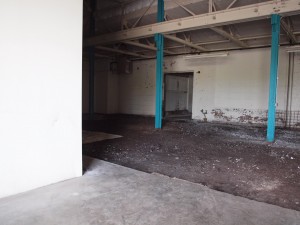
Will LEED 2012 provide points under the new Whole Building Re-Use pilot credit for the reuse of historic buildings such as this brick ward at the Richardson Olmsted Complex in Buffalo?
The green building practices world is in the midst of some major transitions. And that’s saying a lot considering the past 10 years have been nothing but transitions and transformations. The International Codes Council (ICC) is in the midst of creating a new green code, the International Green Construction Code (IGCC). And today, the 2nd public comment for the Next Version of LEED was opened. Final comments for the IGCC are due August 12th , while the comments for LEED are due September 14th. I’m grateful they are, at least, due a month apart. I am reviewing both and preparing comments on behalf of the National Trust for Historic Preservation.
So Much Paper
In order to prepare the comments for the IGCC, I am reviewing 6 different documents at the same time and I need every piece of technology I have to do it without killing a forest. As it is, I printed out two of the documents (250 pages each) and have the other documents open on my two laptops and iPad at the same time. I just mention this anecdotally since it seems rather ironic to me that in order to make our buildings green according to the laws and codes of the land, it takes an unheard of amount of pixels and paper to get there, not to mention, labor. Luckily we have joined efforts with the AIA so that the National Trust and AIA are evaluating the suggested code and its thousands of comments together. The final decisions will be made in Phoenix from November 2-6th. Both the IGCC and LEED processes are public and every comment made on each draft is evaluated and responded to.
Rating LEED

Even my sister’s new dog swim center, Canine Splash, is going green. The existing mercury-laden light fixtures in this historic warehouse are being replaced with T-5 fluorescent bulbs for example.
Reviewing LEED won’t be any less onerous. There are about 1400 pages of the draft rating systems (clean versions and red-lined versions) to review, plus the various scorecards and the comments from the first version. I often find it amazing that someone who is mostly graphic and creative can actually get excited and interested in reviewing all this paper and verbiage. But what I have found, is that the real impact on our buildings and environment is happening in the codes and rating systems. Think about the transformation in the building construction world over the past 10 years – would we all be trying to design and rehabilitate buildings in as green a way as possible if it weren’t for LEED? Probably not. And the ICC probably wouldn’t have developed the IGCC without the pressure of LEED. In fact, my AIA colleagues keep reminding me not to call the sections of the IGCC we are working on “credits”….
A Summer of Changes
This summer has been and will continue to be filled with changes – changes to the way we design and build our buildings. Changes to the way we think about buildings. When even my sister has a section on her new swim center’s webpage entitled “Greening Canine Splash” I know that change is filtering through everyone’s thinking. I will be posting blogs on PreservationNation and my own website and social media venues about the Next Version of LEED and how to comment. So stay tuned – once I submit the IGCC comments, it’ll be full steam ahead on LEED. We will post a blog with advice on how to comment similar to what we did earlier this year. I hope to have the first set of suggestions for people to review posted on PreservationNation mid-August.
And if you’d like to “subscribe” or follow this blog, True Green Cities, please sign up through the “Subscribe” button at the bottom left of this page. You’ll receive a daily recap when new blogs are posted.
